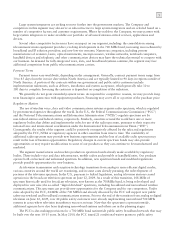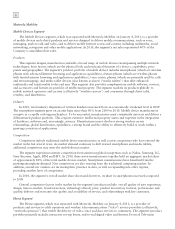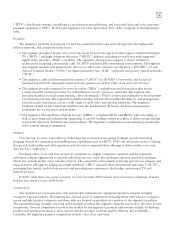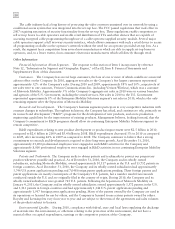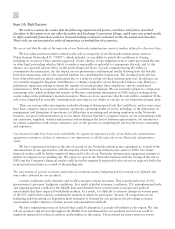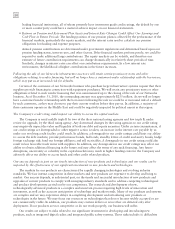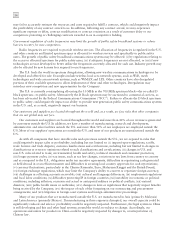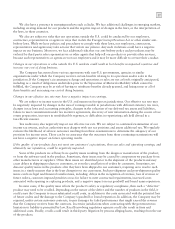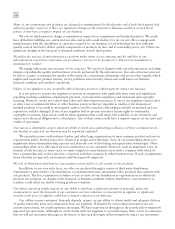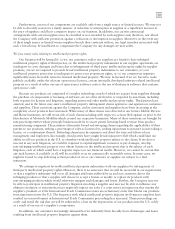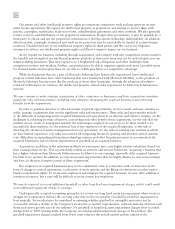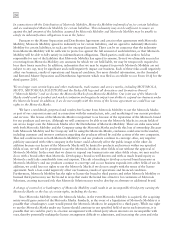Motorola 2010 Annual Report Download - page 22
Download and view the complete annual report
Please find page 22 of the 2010 Motorola annual report below. You can navigate through the pages in the report by either clicking on the pages listed below, or by using the keyword search tool below to find specific information within the annual report.
14
leading financial institutions, all of whom presently have investment grade credit ratings, the default by one
or more counterparty could have a material adverse impact on our financial statements.
•Returns on Pension and Retirement Plan Assets and Interest Rate Changes Could Affect Our Earnings and
Cash Flow in Future Periods: The funding position of our pension plans is affected by the performance of the
financial markets, particularly the equity markets, and the interest rates used to calculate our pension
obligations for funding and expense purposes.
Annual pension contributions are determined under government regulations and determined based upon our
pension funding status, interest rates, and other factors. If the financial markets perform poorly, we could be
required to make additional large contributions. The equity markets can be volatile, and therefore our
estimate of future contribution requirements can change dramatically in relatively short periods of time.
Similarly, changes in interest rates can affect our contribution requirements. In a low interest rate
environment, the likelihood of higher contributions in the future increases.
Following the sale of our Networks infrastructure assets we will retain certain promissory notes and other
obligations relating to vendor financing, but will no longer have a customer/vendor relationship with the borrowers,
which may put us at increased risk for defaults.
Certain of the customers of our Networks business who purchase large infrastructure systems request that their
suppliers provide financing in connection with equipment purchases. We will retain any promissory notes or other
obligations related to such vendor financing that was consummated up to the closing of the sale of our Networks
business. As of December 31, 2010, the outstanding amount was approximately $235 million. As we will no longer
have a customer/vendor relationship with the borrowers following the sale we could be at increased risk of a default
by such customers, as they may choose to pay their current vendors before they pay us. In addition, a majority of
these customers operate in the Middle East and could be negatively impacted by political unrest in this region.
The Company’s credit rating could impact our ability to access the capital markets.
The Company is rated middle triple B by two of the three national rating agencies and low triple B, under
review for upgrade, by the third rating agency. Any downward changes by the rating agencies to our credit rating
may negatively impact the value and liquidity of both our debt and equity securities. Under certain circumstances, if
our credit ratings are downgraded or other negative action is taken, an increase in the interest rate payable by us
under our revolving credit facility could result. In addition, a downgrade in our credit ratings could limit our ability
to: access the debt markets; provide performance bonds, bid bonds, standby letters of credit and surety bonds; hedge
foreign exchange risk; fund our foreign affiliates; and sell receivables. A downgrade in our credit rating could also
result in less favorable trade terms with suppliers. In addition, any downgrades in our credit ratings may affect our
ability to obtain additional financing in the future and may affect the terms of any such financing. Any future
disruptions, uncertainty or volatility in the capital markets may result in higher funding costs for the Company and
adversely affect our ability to access funds and other credit related products.
Our success depends in part on our timely introduction of new products and technologies and our results can be
impacted by the effectiveness of our significant investments in new products and technologies.
The markets for our products are characterized by rapidly changing technologies and evolving industry
standards. We face intense competition in these markets and new products are expensive to develop and bring to
market. Our success depends, in substantial part, on the timely and successful introduction of new products and
upgrades of current products to comply with emerging industry standards and to address competing technological
and product developments carried out by our competitors. The research and development of new,
technologically-advanced products is a complex and uncertain process requiring high levels of innovation and
investment, as well as the accurate anticipation of technology and market trends. Many of our products and systems
are complex and we may experience delays in completing development and introducing new products or
technologies in the future. We may focus our resources on technologies that do not become widely accepted or are
not commercially viable. In addition, our products may contain defects or errors that are detected only after
deployment. If our products are not competitive or do not work properly, our business will suffer.
Our results are subject to risks related to our significant investment in developing and introducing new
products, such as integrated digital radios and integrated public safety systems. These risks include: (i) difficulties



